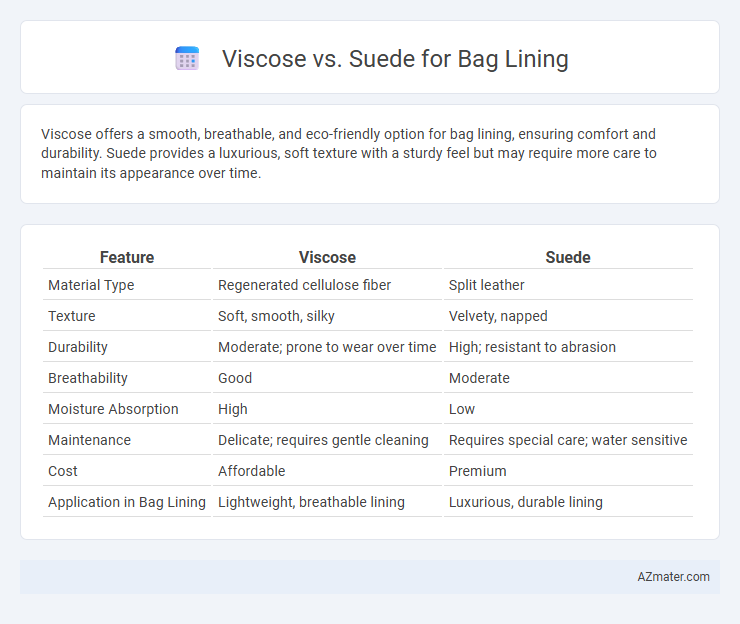Viscose offers a smooth, breathable, and eco-friendly option for bag lining, ensuring comfort and durability. Suede provides a luxurious, soft texture with a sturdy feel but may require more care to maintain its appearance over time.
Table of Comparison
| Feature | Viscose | Suede |
|---|---|---|
| Material Type | Regenerated cellulose fiber | Split leather |
| Texture | Soft, smooth, silky | Velvety, napped |
| Durability | Moderate; prone to wear over time | High; resistant to abrasion |
| Breathability | Good | Moderate |
| Moisture Absorption | High | Low |
| Maintenance | Delicate; requires gentle cleaning | Requires special care; water sensitive |
| Cost | Affordable | Premium |
| Application in Bag Lining | Lightweight, breathable lining | Luxurious, durable lining |
Introduction to Bag Lining Materials
Viscose and suede are popular materials used for bag linings due to their distinct properties and aesthetics. Viscose offers a smooth, breathable, and cost-effective option that enhances the bag's interior softness and durability. Suede lining provides a luxurious, textured feel with excellent resistance to wear, making it ideal for high-end bags requiring both style and longevity.
What is Viscose?
Viscose is a semi-synthetic fiber made from regenerated cellulose, commonly derived from wood pulp, known for its smooth texture and excellent moisture absorption, making it a popular choice for bag linings. It provides a breathable, soft feel inside bags, enhancing comfort and durability while maintaining an affordable price point compared to natural fabrics. Unlike suede, viscose offers greater resistance to humidity and staining, ensuring long-lasting performance in daily use.
What is Suede?
Suede is a type of leather with a napped finish, created from the underside of animal hides, primarily from lamb, goat, calf, or deer. It offers a soft texture and a matte appearance, making it a luxurious choice for bag lining due to its durability and breathability. Compared to viscose, suede provides a more natural, sturdy lining that enhances the overall quality and longevity of handbags.
Comparing Texture and Feel
Viscose lining offers a smooth, silky texture that enhances comfort and adds a luxurious feel to bag interiors, while suede lining provides a soft, velvety surface with a slightly thicker and more tactile quality. Viscose is lightweight and breathable, making it ideal for everyday bags, whereas suede brings a warm, plush sensation often preferred in high-end or vintage-style handbags. Choosing between viscose and suede largely depends on desired texture, with viscose favored for sleekness and suede valued for its rich, cozy touch.
Durability and Longevity
Viscose offers moderate durability with a smooth, breathable texture but tends to wear out faster under heavy use or friction compared to suede. Suede, made from the underside of animal hide, provides superior longevity and robust resistance to abrasion, making it ideal for high-end bag linings that require extended durability. Choosing suede over viscose enhances the lifespan of bag interiors, especially in products subjected to frequent handling and weight.
Breathability and Comfort
Viscose offers excellent breathability due to its natural cellulose fiber composition, allowing air circulation and moisture absorption that keeps bag interiors fresh and comfortable. Suede, while luxurious and soft, tends to be less breathable because it's made from animal hide with a dense, napped surface that traps heat and moisture. For bag linings, viscose enhances comfort by reducing humidity buildup, whereas suede provides a plush feel but may retain more moisture.
Maintenance and Cleaning
Viscose bag linings require gentle cleaning with mild detergents and should be air-dried to prevent damage, as excessive moisture can weaken the fabric. Suede linings, though more durable, demand specialized suede cleaners and a soft brush to maintain texture without causing stains or abrasions. Proper maintenance of both materials ensures longevity, but viscose is more prone to shrinkage and staining compared to the resilient, water-resistant nature of suede.
Environmental Impact
Viscose for bag lining is derived from natural cellulose but involves chemically intensive processing that can produce harmful effluents, raising environmental concerns when not managed responsibly. Suede, typically made from animal hides, has a higher environmental footprint due to resource-heavy livestock farming and chemical treatments used in tanning. Choosing sustainable sourcing and responsible manufacturing practices is crucial to minimizing the environmental impact of both viscose and suede linings.
Cost Comparison
Viscose lining for bags generally offers a lower cost compared to suede, making it a budget-friendly option for manufacturers and consumers. Suede, made from leather with a soft texture, tends to be pricier due to its durability and premium feel. The cost difference reflects not only material expenses but also the processing and maintenance required for each lining type.
Best Uses: Which Lining to Choose?
Viscose is ideal for bag linings that require a smooth, breathable, and lightweight fabric, making it perfect for everyday or casual bags where comfort and moisture-wicking properties are important. Suede offers a luxurious and durable option that enhances the interior aesthetic of high-end or statement bags, providing a soft, textured feel suited for premium designs. Choosing between viscose and suede for bag lining depends on the desired balance between functionality, comfort, and style, with viscose favored for versatility and suede for sophistication.

Infographic: Viscose vs Suede for Bag Lining
 azmater.com
azmater.com